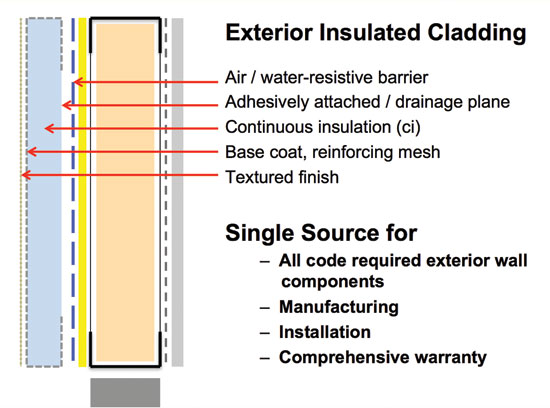EIFS - Performance Beyond Code Compliance
Exterior Insulation and Finish System: Performance Solutions
In light of the challenges and limitations of using traditional construction to meet the requirements of the 2012 code including the 2010 ASHRAE 90.1, Exterior Insulation and Finish Systems (EIFS) are being looked at for a growing number of projects. These systems were first developed in Europe in the 1950s to address increasing energy cost and post war re-development. In 1969 they were introduced to the United States which means that the industry has 44 years of experience as the building system that can claim to be the “original continuous insulation.” During that time, they have been installed on over 1 million buildings in North America primarily by companies with manufacturing facilities in the U.S.
Since EIFS are engineered and designed as complete ci systems, they very effectively address all of the ci provisions of the code. The insulation in these systems is intended to be installed as a continuous layer over the outside of sheathing to provide both thermal insulation properties and to act as a substrate for the durability and aesthetic layers of the EIFS assembly. Hence, they provide a complete exterior surface that eliminates virtually all thermal bridging in most cases allowing the insulation to perform up to its full potential. That also means that metal studs can be sized only as needed to address structural design issues since their depth is no longer needed for perceived R-value increases through thicker cavity insulation. Although EIFS are more commonly installed on wall assemblies with cavity insulation, the ci value of EIFS can be selected so that they do not require any additional insulation to meet the performance goals. In that case, the stud cavity is available for running mechanical and electrical lines cleanly and efficiently without interference or interruption of the cavity insulation.
 |
Typical components of an EIFS. Image courtesy of Dryvit Systems, Inc. |
A typical EIFS is made up of several components installed from the face of the exterior wall sheathing on an exterior wall and progressing outward. Currently EIFS with integral moisture drainage are most widely specified for commercial construction. This type of system includes a proprietary fluid applied air/water resistive barrier (AWRB). It is installed directly over the face of the sheathing and includes a treatment of all sheathing board joints as well as all inside and outside corners. The AWRB is then properly integrated through the use of compatible fluid or membrane flashing materials into all transition, wall penetration, rough opening and contiguous wall infill areas all as a means of creating the needed continuous air barrier throughout the entire exterior wall envelope.
Next, adhesive applied in a specific vertical notched trowel pattern is used to both secure the ci layer to the AWRB and to create an integral draining plane. Once the insulation boards are set in place, their outside faces and return edges are encapsulated with a fiberglass mesh reinforced base coat. This mesh adds strength, durability and impact resistance to the outside primary weathering surface. When ready, the reinforced base coat is covered with a final textured aesthetic finish coat. Since all of these layers are installed by the same trade, there is a single source for all code required exterior wall components, for the manufactured products, for their installation, and for a comprehensive “system” warranty.
In looking at the wall system as a total assembly, it is important to first note that all EIFS have been tested for compliance with NFPA 285 for foam plastic insulation and air/water-resistive barriers and pass the fire safety requirements accordingly. Further, without the need for a separate veneer or cladding, EIFS become single source systems for all components of an exterior wall assembly other than the structure and the sheathing.
EIFS have a ripple effect on the rest of the building design as well since they are extremely lightweight weighing on average only 1.5 pounds per square foot. This has a notable impact on the total weight of the exterior wall which can ripple through to the structural system requiring lighter and smaller columns, beams, footings, etc. dramatically saving construction cost. In a similar manner, since an additional veneer layer isn't needed, that means that the wall system doesn't get unduly thick or complicated to detail. This keeps all exterior wall penetrations such as at doors, windows and louvers very conventional to detail and easier to build. All together, EIFS represent very positive attributes when evaluating exterior veneer or cladding options.









